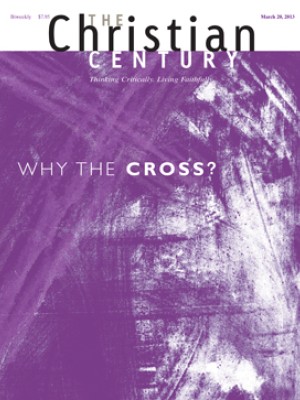Sunday, March 31, 2013: John 20:1-18
In John's Easter account, people spend the day running around trying to come to terms with what God has done in the night.
Over the past 18 years my image of Easter has undergone a night-and-day change. I don’t mean metaphorically; I mean that in my mind’s eye Easter unfolds not in the daytime or at sunrise, but at night.
The curtain of darkness is described in John’s Gospel: Mary discovers the empty tomb “early . . . while it was still dark.” According to John, if one arrives for the sunrise service at the first Easter, it’s already too late. However we may think about the resurrection, John has it taking place under the cover of night.
This darkness creates a hole, a gap in the Easter story where the crucial event takes place. The Gospels are silent as Christ rises like a thief in the night. In John, no well-informed angels rushed in to explain the missing body. When angels finally did appear, they had no answers but only a question: “Woman, why are you weeping?” Mary had expected to find at least a corpse; instead she found a void, an opening in the darkness.
Read our latest issue or browse back issues.
The Easter I grew up with was full of light, brass, banners and rows of people standing for one bold hymn after another. For the past 18 years, however, I’ve celebrated Easter under the cover of darkness at the Vigil of Easter, an ancient service now being recovered by denominations around the world. The experience of those years has given me images of resurrection that are like visions from a dream.
I helped seminary students learn to lead this service during a January-term travel seminar into a mountain wilderness. One night, in a meadow of deep snow out under the stars, we practiced the first ritual action of the Easter Vigil: lighting the new fire. Each student stomped down a patch of snow and set up a small tepee of kindling and split logs, then pulled apart raw cotton and placed it inside the set-up wood. In what looked like a lesson at Hogwarts, each student took a slab of magnesium and a knife, drew the backside of the knife hard against the mineral and began learning how to throw sparks into the tinder. As the students crouched over the wood, the sparks lit up the fog of their breath and flashed glimpses of their faces set in concentration or frustration. One by one the fires caught and glowed orange, red and yellow. The snow-filled meadow grew blooms of light and heat. Each student prayed a fire blessing over these fires struck from rock: “Bless this new fire, and increase in us a desire to shine forth with the brightness of Christ’s rising, until we feast at the banquet of eternal light” (Evangelical Lutheran Worship).
This 21st-century cohort of pastors-to-be needed no interpretive help in appreciating the significance of striking the Easter fire in the cold and dark of night.
At the Easter Vigil the mysteriously powerful—even dangerous—outdoor fire is ritually passed to the large paschal candle and carried inside to burn in the mostly darkened space while worship leaders read scriptural narratives. These ancient stories from Hebrew scripture—some congregations read as many as 12—speak of a God who acts in the world’s nighttime. Under the cover of darkness, slaves cross rivers into freedom; dry bones rise up to live; the fiery furnace of the tyrant Nebuchadnezzar goes dark; and long before any human eyes have opened, a blue-green world is given light and a sheltering dome of air, while the land, sea and sky are filled with fruitful creatures of every shape and kind. From the beginning, God has called new life out of darkness, often against great odds.
In the Gospel of John most of the action in the light of Easter day is made up of people literally running around trying to come to terms with what God has done in the night. God raises the dead before the world is fully awake to what is happening. We are caught off guard and struggle to catch up.
In the reckoning of time practiced in Judaism and inherited by Christianity, the new day begins not at a mathematically determined midnight or at the start of the human workday, but at sunset, as humans go to rest. As Dorothy Bass writes, this way of keeping time inaugurates each day with the fertile darkness of divine grace that renews the face of the earth in advance of our own efforts: “The first part of the day passes in darkness . . . but not in inactivity. God is out growing the crops even before the farmer is up and knitting together the wound before the clinic opens” (Receiving the Day).
Every year I see infants and adults baptized into this nighttime grace at the Easter Vigil. As they go down into the water under the cover of night, I am drawn into that holy, mysterious darkness too—and am caught off guard by the light and life that is rising there and in every night and valley of the shadow.





